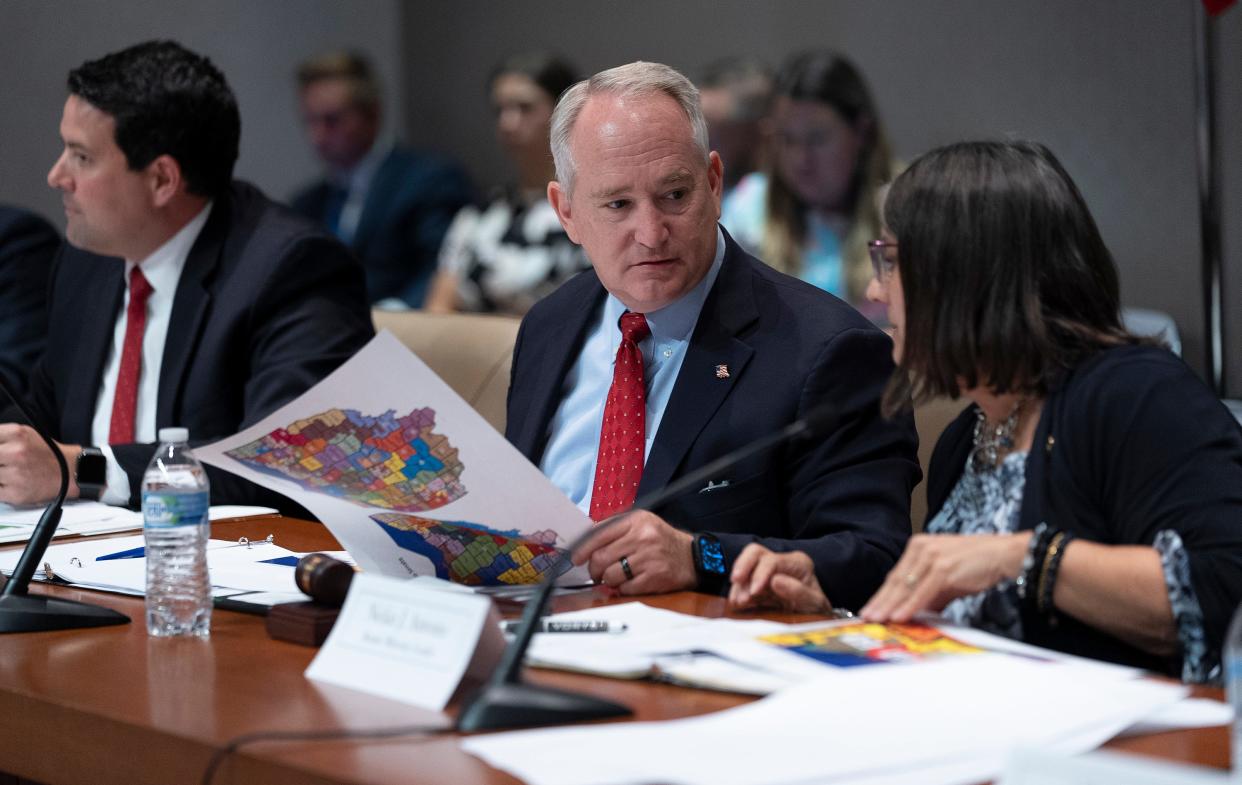The "best deal" on voting maps was not good enough for Ohio voters| Thomas Suddes

- Oops!Something went wrong.Please try again later.
- Oops!Something went wrong.Please try again later.
Thomas Suddes is a former legislative reporter with The Plain Dealer in Cleveland and writes from Ohio University. tsuddes@gmail.com
To call Tuesday night’s approval of GOP-devised Ohio General Assembly districts a travesty does an injustice to the riches of the English language — even though it won the backing of the redistricting commission’s two Democrats, Senate Minority Leader Nickie Antonio, of Lakewood, and House Minority Leader Allison Russo, of Upper Arlington.
Sad, sober reality: Allison Russo on why Democrats had no option but to support bogus maps
Arguably, the Democrats voted for what they believed (probably accurately) was likely the best deal they could get.
That “best deal” argument cut no ice with the Equal and Fair Districts Coalition, which wants to place a redistricting reform plan on Ohio’s 2024 statewide ballot.
The districts approved Tuesday, the coalition said, “are still illegally gerrymandered [and] shockingly garnered the support of the two lone Democratic commission members.”

Retired Ohio Supreme Court Chief Justice Maureen O’Connor, a Republican who’s called for redistricting reform, said Tuesday map is “a bipartisan gerrymander by politicians who decided to protect themselves and their friends, ignoring the people of Ohio.”
The districts OK’d Tuesday will likely result in the election of an Ohio House with Republicans winning in an estimated 62% of its seats and an estimated 70% of the Senate’s seats. Currently, Republicans hold 68% of the House’s seats and 79% of the Senate’s.
In contrast – though it’s an imperfect comparison because presidents are elected statewide, not by districts – Ohio cast 51.4% and 50.6% of its vote for Democrat Barack Obama in 2008 and 2012, respectively, and 51.2% and 53.2% of its vote for Republican Donald Trump in 2016 and 2020.
The upside of Gerry-palooza ’23 is that what the GOP did is so lopsided it’ll induce voter support for the Equal and Fair coalition’s 2024 ballot issue.
General Assembly Republicans’ dimness in proposing August’s voter-rejected Issue 1 (to require 60% majorities to amend Ohio Constitution), GOP legislators may have awakened a sleeping giant.
November’s Issue 1 – to guarantee Ohioans’ access to abortion – stands a good chance of winning voter approval.
Why?
Because of mass-mobilization techniques that were honed by those who stymied August’s attempted coup. There’s something stirring out there – not that Statehouse Republicans’ tin ears hear it.
Perfect place for grifters
The Redistricting Commission Republicans held several regional hearings in far-flung state parks, notably Deer Creek State Park, 30-35 miles southwest of the Statehouse, near Mount Sterling (population about 2,000) in Madison County – far away from diverse Columbus and equally far away from public transportation.
Small world: One of Deer Creek features is the (restored) Harding Cabin, a summertime hangout for a group of Statehouse grifters and GOP hangers-on in the entourage of future President Warren G. Harding, of Marion.
The cabin belonged to Harry M. Daugherty (“dock-er-tee”), a Washington Court House lawyer. Daugherty was a former Ohio House member who later arguably became the original Statehouse superlobbyist especially for utilities (sound familiar?), and big national companies of all kinds that then feared Ohio regulators. (Yes, Ohio regulation once was formidable.)
The cabin was a place for GOP insiders to drink, play cards and scheme.
For a time, Daugherty was also Ohio’s Republican state chair and one of Harding’s biggest boosters. After Harding won the presidency in 1920, he named Daugherty U.S. attorney general. In Columbus, Daugherty was seen as capo of what came to be called the Harding Gang, renamed, in Washington, the Ohio Gang, whose unofficial headquarters and party house became known as the national capital’s “Little Green House on K Street.”
That crafty Columbus clique, considering some of its capers, might well have considered this decade’s FirstEnergy affair child’s play. After Harding died in 1923, Daugherty was tried on official corruption charges, but ultimately escaped conviction. He died in 1941 in Columbus.
So, whether the GOP Redistricting commissioners knew it or not, Deer Creek State Park was the perfect setting for a stage-managed floor show about Ohio’s state Senate and state House of Representatives districts.
Given Daugherty’s background, the GOP’s redistricting commissioners could not have picked a more symbolic spot for a bit of partisan engineering – which, at this writing, is what Ohio’s current redistricting “process” amounts to.
Thomas Suddes is a former legislative reporter with The Plain Dealer in Cleveland and writes from Ohio University. tsuddes@gmail.com
This article originally appeared on The Columbus Dispatch: Will Ohio redistricting fiasco energize voters to fight for fairness?

